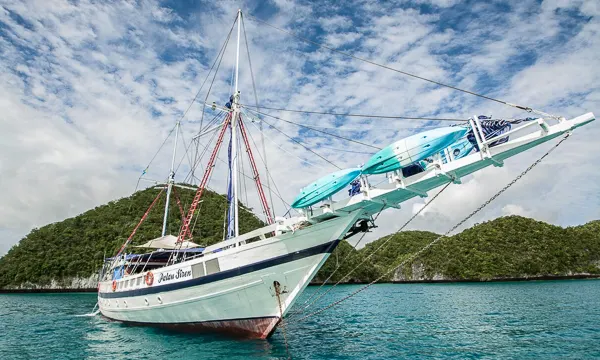
Scuba diving in
Pacific IslandsDiving Highlights
- Pristine reefs, and channel dives with legendary pelagic marine life
- Sobering wartime wrecks littered with artefacts and carpeted in coral
- Incredible biodiversity supported by huge marine protected areas
- Diverse underwater landscapes with plummeting walls, channels and fringing reefs
The Pacific Islands are a mecca for scuba divers, with an incredible variety of oceanic experiences on offer. Like oases in the desert, tiny specks of land soar from the abyssal depths, creating beautiful island chains that attract pelagic wildlife of every size. The region also has a rich and fascinating seafaring history, from the first settlers navigating by the stars, to whaling, pirates, and world war battlegrounds. Visitors can explore thousands of islands, boasting lush tropical rainforests, stunning white sand, and diverse cultures. And, each island group boasts its own colourful heritage, with unique cuisines, traditions, languages, and landscapes!
Below the waves, this massive region is home to hundreds of shipwrecks, breathtaking current-swept reefs and atolls, and some of the planet’s healthiest populations of pelagic marine life. Thousands of fish and coral species are found here, as are supersized and show-stopping animals such as mighty whale sharks and manta rays, migratory cetaceans including whales and dolphins, and over a dozen different shark species.
Top Pacific Islands experiences

Dive Palau’s famous Blue Corner, Palau
One of the Pacific’s most famous dive sites, Blue Corner is home to fast-moving currents and big fish galore. Divers can watch in wonder as sharks and huge numbers of fish cruise by in the blue.

Explore sombre wartime shipwrecks, Palau
Towards the end of 1944, Palau was the scene of an infamous battle between Japanese and Allied forces. Over 60 Japanese ships and American planes came to rest here, some of which can now be explored by scuba divers.

Swim with thousands of stingless jellyfish, Rock Islands
As well as spectacular scenery, the Rock Islands are home to a unique saltwater lake, home to vast schools of stingless jellyfish. Snorkelers can dive in amongst the jellyfish as they migrate back and forth across the surface, following the sun.

Encounter manta rays at bustling cleaning stations, Palau
Palau’s German Channel was cut into the reef to ease transportation and shipping. Its powerful currents and cleaning stations found just outside now make it a hotspot for manta rays during the season.

Visit the legendary nuclear ghost fleet, Bikini Atoll
Descend to beyond recreational depths and explore the iconic ghost fleet of Bikini Atoll. Banished to the depths during the testing of nuclear bombs, there are few sites as eerie and adventurous as this.

Witness the sublime scenery of Leru Cut, Solomon Islands
Divers can enter this underwater canyon and swim around 100-metres into the interior of an island – all the while bathed by beautiful blue light – creating a serene atmosphere and unique photographic opportunities.

Explore the highest concentration of WWII wrecks, Chuuk Atoll
Chuuk Atoll – also known as Truk Lagoon – is home to the highest concentration of WWII wrecks in the world, featuring more than 50 individual sites within a single atoll, many of which are within recreational depths.
Pacific Islands scuba diving seasons
Spread out over thousands of miles, and surrounded by deep open ocean, there’s obviously no standard scuba diving season across all Pacific Islands. That said, these isolated outposts typically enjoy a fantastic year-round climate, with steady air temperatures and warm, clear waters which often lend themselves to year-round diving.
Generally speaking, most Pacific Islands experience two monsoonal periods throughout the year. These commonly occur around December to April and June to October, though the exact timings can differ by a month or two between destinations. The months in between each monsoon are referred to as ‘shoulder seasons’ and are often characterised by minimal wind. Exactly which season brings the wettest weather also varies greatly between destinations, but diving can often continue regardless and, in any case, visitors should prepare for sporadic downpours at any time of year.











